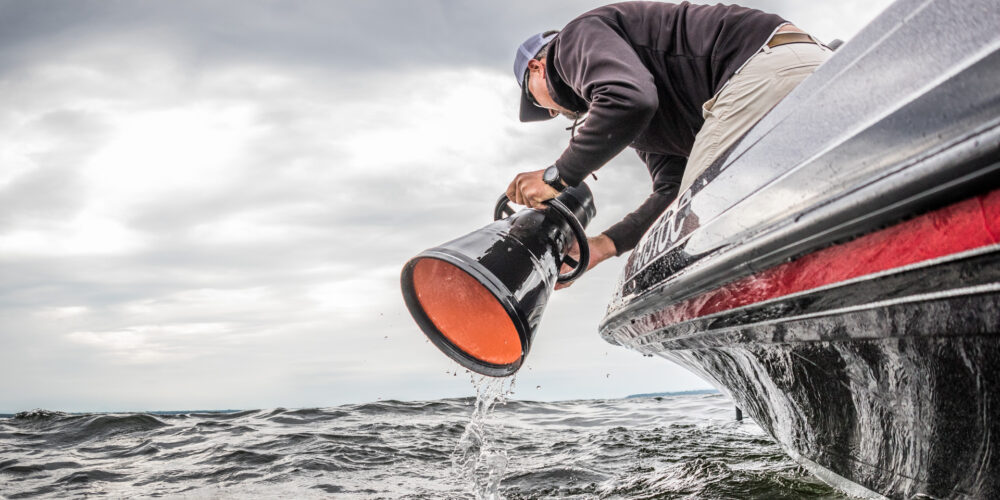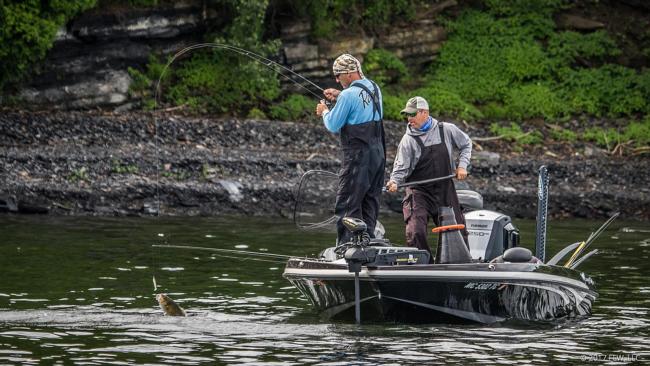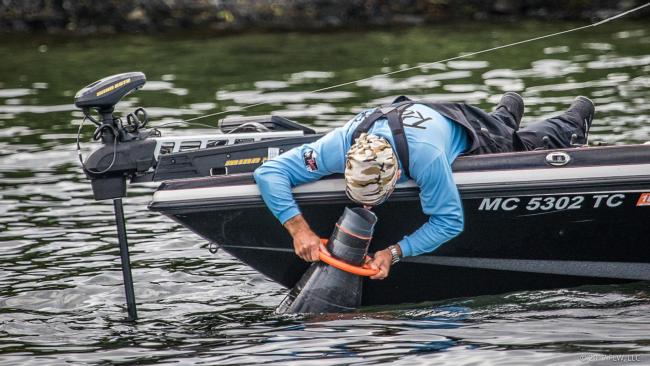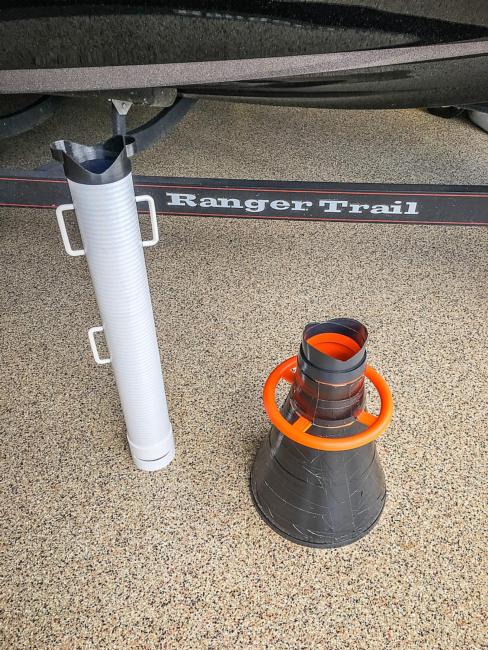The Bassin’ Bathyscope
How to use this unique contraption for seeing bass underwater

(Editor’s note: This story was first published in July of 2017 and updated slightly in June of 2021.)
Modern devices for finding bass usually require some sort of battery power source to use them in a boat, but at the 2017 FLW Series event on Lake Champlain the device that got the most attention from fans who followed along was a big orange cone that anglers were peering through while leaning over their gunwales.
Technically called a bathyscope, the device is basically a plastic cone with a viewing window on the narrow end. When the wide bottom end is placed in the water, the user can peer through the top and get a clearer look at what’s down below, which is extremely handy for sight fishing deep smallmouths on overcast or choppy days.
We first reported on bathyscopes in a 2011 magazine article, shortly after pro angler Chad Pipkens and his friend Jeff Cox imported one from Europe to use for sight fishing on clear-water lakes of northern Michigan, and Poor Boys Baits, who sponsored Pipkens at the time, began selling them on its website. That device, which is known as the Flogger – also the most common “street name” among anglers – is still sold under the LureCraft brand name at sites such as Tacklewarehouse.com.
Reportedly, it was originally used for underwater viewing tours in Europe, and similar models are used for other aquatic pursuits around the world.
Scott Dobson, who’s also from Michigan, is one of the anglers who adopted the bathyscope for bass tournament fishing. He used it extensively to finish ninth on Champlain, where the tournament days coincided with a surge in deep smallmouth bedding activity.
To find deep smallmouth beds is the most popular reason why the bathyscope is used by anglers, and if you’re content to sight fish smallies without one, you might be missing out.
“I think a lot of guys can see beds, but they can’t see if the fish is actually in the bed,” Dobson says, referring specifically to smallmouths. “Up here in the northern lakes in Michigan, a lot of fish will spawn deeper than 8 feet. If it’s flat calm and sunny and the water is clear, you can see the bed, you can see the fish on it and you can judge the size of the fish. When you get beds deeper than that, say up to 12 or 15 feet, or you get ripples or drops of rain, it’s much harder to see them and judge their size. When you drop that bathyscope in the water it basically takes the glare and ripple off the surface. Once you get a trained eye and you do it enough, you can kind of gauge the size of the fish.”
At Champlain, in particular, Dobson says many of his fish were very tricky to locate because they were locked down so much that they barely moved. Also, the bottom content was dark, and so were the beds. The bathyscope made it much easier to locate the biggest fish in practice and re-locate them in the tournament.

Tournament Advantages
The size evaluation aspect of sight fishing is critically important at places such as Champlain, where catching bass isn’t overly challenging and a lot of 3-pound-class and smaller fish get brought to the scales. To win, it’s necessary to catch those slightly larger 3 1/4- to 3 3/4-pound fish, with 4-pounders being worth a lot of cash. Plus, according to Dobson, many of the bedding smallmouths he encountered at the most recent derby on the New York/Vermont border lake were set up in small “colonies” of 15 to 20, and they were grouped together roughly by size. For him, the bathyscope was critical for picking out those key 3-pounds-plus fish within a group of straight 3-pounders.
He says the best way to learn to evaluate fish size is to look at the fish through the scope, study its form while considering the depth and distance away, and then catch it and weigh it. Over time, you’ll develop your eye.
“If you’re looking through the scope on a 6-foot-deep bed, and you put the scope a half a foot underwater, the fish might look large, but in actuality it might not be. You’re just closer to the fish,” Dobson says. “I start by looking at the fish’s back and if it has a belly on it. It [judging size] just comes with a lot of practice and catching the fish after you see them.”

Dobson’s Bathyscope System
Under the time constraints of a tournament practice and competition day, it’s important to have an efficient search system, particularly if incorporating a bathyscope into the process.
For Dobson, two important keys are a cooperative co-angler practice partner and the Minn Kota Ultrex.
He’s been practicing with co-angler Bryan Doyle of Holland, Ohio, for the last couple of years, and Doyle has some experience using scopes. Their practice strategy relies on a combination of traditional “stand-on-the-deck-and-look” sight fishing and looking under the surface with the scope.
Dobson, at 6 feet, 1 1/2 inches tall, says his height gives him an advantage when spotting for beds while cruising on the trolling motor. When he finds one, he drives over it with Doyle sprawled out on the front deck, peering through the scope. When encountering a spawning area where smallies are grouped up, as previously described, Dobson can then handle the scope and study each fish.
“I had two areas [at Champlain] that had 15 to 20 beds that I found when it was rough and the waves were crashing in there that I could see moderately well,” Dobson recalls. “And then we used the Flogger to gauge them.”
Dobson also took his system another step on Champlain. He took advantage of the fact that when smallmouths are fully locked down on beds they’re extremely territorial and will usually bite the first bait to fall near the bed. They also don’t often spook away from a trolling motor overhead. Knowing their aggressiveness, in practice Dobson parked directly overhead and caught every fish that he thought was the right size. He then weighed each fish, released it, marked a waypoint and recorded the details on his GPS unit, including fish size and any underwater object such as a distinguishable rock or piece of wood that would help him dial in on the fish again in the tournament. Once the competition began, he drove straight back to the waypoint, parked overhead and went to work using the scope and his Ultrex.
“I knew where the beds were, and I’d get close with my Ultrex and Spot-Lock on the bed,” he says. “Then I could look at the beds.
“The cool thing about the Ultrex over the old cable-driven trolling motors is I can lie down on my belly and steer the foot control with my hand because it’s electric steer and it doesn’t flop around,” he adds. “You can also use the remote control, but if it’s hanging around your neck while you’re lying down then it’s in the water. So I just steered with my hand on the pedal.”
More Tournament Tips
Most of Dobson’s catches came after just one or two drops – the first chance with a drop-shot, and the second with a tube.
He says that in some instances he’ll drop his bait and fish it while still looking through the scope.
“If I’m lying on my belly, I can do that with that Ultrex more so now,” he says. “In the past you could only do that on a calm day when the wind wasn’t blowing.”
When he’s “scope fishing,” Dobson has an interesting approach. Parked over the fish, he drops the bait down to the water, lets out a bit of slack, puts down the rod and then takes control by holding the line between his thumb and forefinger. He then peers through the viewfinder and works the bait into the bed.
“When the fish gets it I set the hook with my hand,” Dobson says. “Then I can drop the Flogger, because it floats, then grab the rod and reel it in.”
Using no-stretch braided line above his fluorocarbon leader and fishing with a drop-shot both help with the hookset. The drop-shot hook is very fine and requires little pressure to penetrate. It also hooks the fish in the jaw or side of the mouth most of the time, which is desirable over the larger tube hook he uses because, according to Dobson, the tube hook sometimes hooks fish deep in the roof of the mouth, where it can cause unnecessary injury. At Champlain, anglers were not allowed to cull fish that were starting to expire and couldn’t swim away. He says the drop-shot was much less likely to cause that type of severe or mortal wound, which protected the fish and negated the possibility of having to keep a fish that he otherwise might have been able to cull.
The hand-held method itself allows for perfect accuracy and, in some instances, lets him hook fish that he might otherwise miss.
“I notice it even when coaching my co-angler; they don’t even feel it [the bite],” Dobson says. “There are so many times you’re looking through that scope when the fish grabs the drop-shot, in particular, and there’s a delay between when the fish grabs it and the bite is transmitted through the line. There’s almost a second delay. By then they spit it out.”

Gear Tips
Dobson says the bathyscopes he’s encountered have only a clear viewing lens with no magnification. The funnel shape of the Flogger expands the viewing range, and by extending his arms and tipping the cone side to side, Dobson can see out 10 yards or so to the side.
He wraps his cone with black duct tape to cut out light penetration. The tape adds a bit of weight, but not enough to be a bother.
The most frustrating part of using it, according to Dobson, is that the constant standing and kneeling and shuffling around on the deck can get tiresome. Plus, the Flogger is so light that it can bounce in waves and smack the user in the face.
Also, the popular Flogger model is cumbersome to haul around in a bass boat. Dobson takes it along when he knows he’s likely to use it a lot. Otherwise, he keeps a similar, yet smaller device called the FissureMan in the boat.
“I bought this other unit from a gold prospecting website [goldsucker.com], and it’s essentially PVC pipe that’s about 3 1/2 feet long and more compact,” Dobson says. “I can put it in a rod locker. The only problem with it is the viewing lens [on the bottom] is only 4, maybe 4 1/2 inches across. It’s a straight pipe with a lens across the bottom of it. It’s basically drain and sewer pipe. It’s already coated black on the inside and has little handles on it. It’s for looking in gold rivers to find gold fragments.”
He also recently tracked down a larger bathyscope that’s similar to the Flogger and is sold on a European carp fishing website, but was unable to get it shipped in time for Champlain. Other anglers have reportedly built their own out of everything from Plexiglas and trashcans to various plastic pipes or buckets.
Tacklewarehouse.com sells the Flogger for $114.99, though Dobson says that with a little online research he was able to find a similar device for less than half the price. Amazon.com lists numerous other bathyscopes of various make and size – even models similar to the Flogger that break down into several pieces for more compact storage. One of the alternatives might be just the ticket for a tournament angler.
Other Uses
Bathyscopes like the Flogger are specialty tools that, as described, are extremely valuable for finding deep bedding smallmouths in air-clear water. If you don’t live in the Upper Midwest, Canada, the Great Lakes, New England or other areas where those scenarios are common, a scope might still have some uses.
Dobson has used his to identify deep grass types and bottom content changes, and even to spot bass on deep grass or structure. Obviously, water clarity would limit the effective viewing range, but there are plenty of clear-water impoundments throughout the continent where it might have similar uses.
And if anything, having one in your tackle collection will ensure that when you finally make that early summer trip to Champlain (as any bass nut should), you’ll be prepared should some angry bronzebacks still be on their spawning beds.